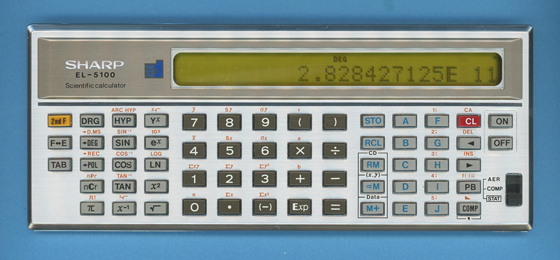
DATAMATH CALCULATOR MUSEUM
 |
DATAMATH CALCULATOR MUSEUM |
Sharp EL-5100
| Date of introduction: | June 1979 | Display technology: | LCD dot matrix |
| New price: | $100.00 (MSRP 1979) | Display size: | 24 characters |
| Size: | 2.8" x 6.9" x 0.40" 70 x 175 x 10 mm3 |
||
| Weight: | 4.0 ounces, 114 grams | Serial No: | 91032669 |
| Batteries: | 3*LR44 | Date of manufacture: | mth 9 year 1979 |
| AC-Adapter: | n.a. | Origin of manufacture: | Japan |
| Precision: | 12 | Integrated circuits: | CPU: SC43153 DISPLAY, RAM: 3*SC43125 |
| Memories: | 11 | ||
| Program steps: | 80 Bytes | Courtesy of: | Ken H. Meine |

![]() Sharp
Corporation introduced in June 1980 with the PC-1211 (and its sibling
PC-1210) the World's first Pocket Computer with BASIC programmability.
While it looks at first glance like a continuation of this EL-5100, a keystroke
Programmable Pocket Calculator introduced in June 1979, did the PC-1211 add
another medal to the impressive list Sharp's
Calculator Innovations:
Sharp
Corporation introduced in June 1980 with the PC-1211 (and its sibling
PC-1210) the World's first Pocket Computer with BASIC programmability.
While it looks at first glance like a continuation of this EL-5100, a keystroke
Programmable Pocket Calculator introduced in June 1979, did the PC-1211 add
another medal to the impressive list Sharp's
Calculator Innovations:
| • Micro Compet QT-8D (Oct. 1969): World’s first electronic calculator incorporating LSI ICs • EL-8 (Nov. 1970): World’s first battery operated portable calculator • EL-805 (May 1973): World’s first COS electronic calculator • EL-8020 (1976): World’s first calculator using Film Carrier System and yellow LCD • EL-8026 (1976): First electronic calculator with solar cells (disputed) • EL-8130 (1977): World’s first touch key calculator • EL-8152 (1979): World’s first 1.6mm-thin electronic calculator • EL-5100 (1979): World’s first direct formula entry scientific calculator • PC-1211 (1980): World's first Pocket Computer with BASIC programmability |
We assume that both Hewlett Packard and Texas Instruments, leading in 1980 the market or Programmable Pocket Calculators were impressed by the Sharp PC-1211 and its identical twin Tandy Pocket Computer PC-1, the former company introduced roughly one year earlier with their HP-41C the successor of the ancient HP-67 and the latter was working on "Project X" with the goal to replace its legendary TI-59 and regain leadership in the cat and mouse game with Hewlett Packard.


 Learn more about the demanding "Project
X" initiated already in Summer 1977 and leading not only to the (failed) TI
Programmable 88, but the TI-66 PROGRAMMABLE,
failed TI-76 PROGRAMMABLE, Compact Computer
CC 40, (failed Compact Computer CC 70)
and last but not least the successful TI-74
BASICALC and TI-95 PROCALC.
Learn more about the demanding "Project
X" initiated already in Summer 1977 and leading not only to the (failed) TI
Programmable 88, but the TI-66 PROGRAMMABLE,
failed TI-76 PROGRAMMABLE, Compact Computer
CC 40, (failed Compact Computer CC 70)
and last but not least the successful TI-74
BASICALC and TI-95 PROCALC.
This Sharp EL-5100 keystroke Programmable Pocket Calculator, introduced in
Summer 1979 together with its siblings EL-5101 and EL5102 with smaller displays
and the EL-5103 sporting a traditional "portrait" style appearance, introduced a
new concept of programming. With the EL-5100 advertised as "Scientific
Calculator speaking a new language", a subtle [AER] (Algebraic Expression
Reserve) position of a small switch allows the user to enter a Formula with up to 80 characters as it
would be written in a textbook:
| • [AER] A2 + B2 • [COMP] 2 STO A, 3 STO B • COMP: Answer 13 |
![]()
![]() Dismantling this Sharp EL-5100 manufactured in
September 1979 by Sharp Corporation in Japan reveals a
clean design based on just one printed circuit board (PCB) populated with a 4-bit
microcontroller and three Integrated Circuits (ICs) to drive the alphanumeric LC-Display with
144*7 pixels and provide additional memory space for the calculator. Learn how
to decipher the
91032669
Date code hidden in the
serial number of the pictured calculator.
Dismantling this Sharp EL-5100 manufactured in
September 1979 by Sharp Corporation in Japan reveals a
clean design based on just one printed circuit board (PCB) populated with a 4-bit
microcontroller and three Integrated Circuits (ICs) to drive the alphanumeric LC-Display with
144*7 pixels and provide additional memory space for the calculator. Learn how
to decipher the
91032669
Date code hidden in the
serial number of the pictured calculator.

 The PCB of the featured EL-5100 is very similar to the larger
of the two PCBs found with the PC-1210 and PC-1211 and sports the listed Integrated
Circuits:
The PCB of the featured EL-5100 is very similar to the larger
of the two PCBs found with the PC-1210 and PC-1211 and sports the listed Integrated
Circuits:
| • SC43153: CPU - 4-bit microprocessor manufactured by Sharp
in a CMOS process and using a 62-pin QFP (Quad Flat Pack) package • 3*SC43125: Display driver with built in RAM (128*4 Bits), manufactured by Sharp in a CMOS process and using a 62-pin QFP (Quad Flat Pack) package |
The 4-bit microcontroller share a common data bus with the three Display chips. One display chip holds the 11 memory registers, one provides the space for the Formula Program, and one provides scratchpad space for the microcontroller.
If you have additions to the above article please email: joerg@datamath.org.
© Joerg Woerner, January 24, 2021. No reprints without written permission.